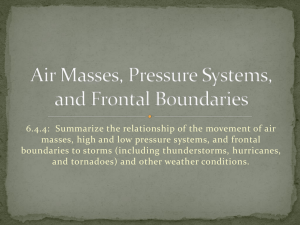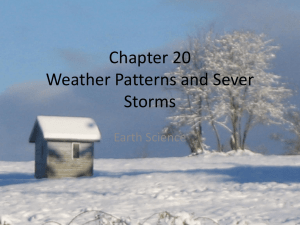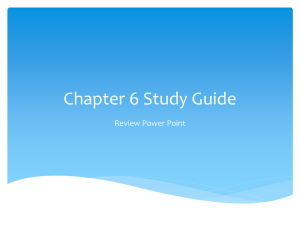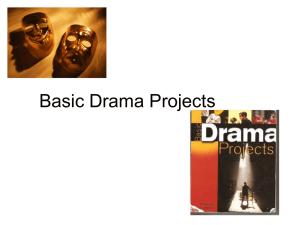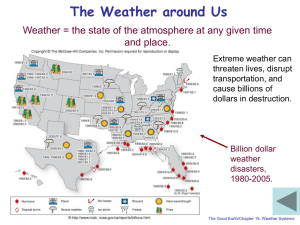What kind of weather would a continental tropical air mass that
advertisement
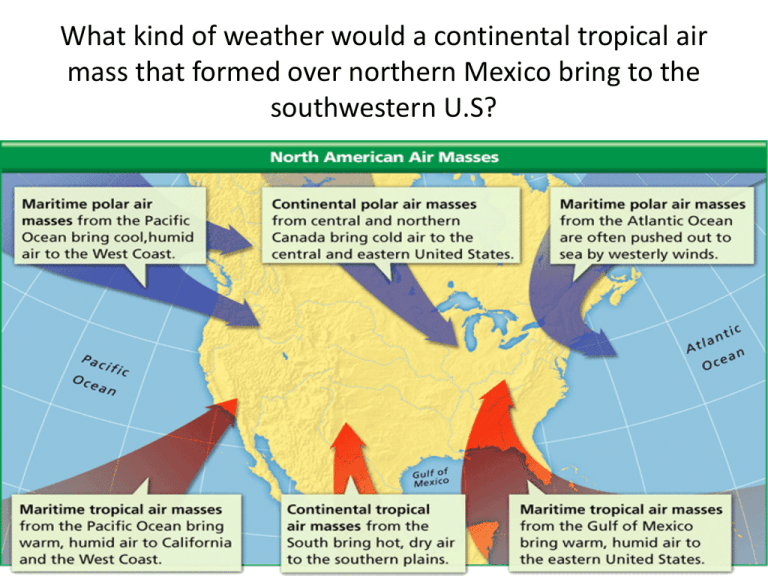
What kind of weather would a continental tropical air mass that formed over northern Mexico bring to the southwestern U.S? Fronts Front - boundary between 2 different air masses. Fronts usually bring some type of precipitation. Cold Front Cold front – rapidly moving cold air overtakes the slower moving warm air; The warm air quickly rises allowing water vapor to condense. Thunderstorms and severe weather are common at these fronts. (Draw a picture of a cold front.) Cold Front On a weather map a cold front is represented by blue triangles. Warm Front Warm front - warmer air slowly moves over colder air and replaces it; Leads to long periods of steady rain or snow. (Draw a picture of a warm front.) Warm Front • On a weather map a warm front is represented by red semi-circles. • warm and cold front animations • cold front precipitation • warm front precipitation STAtionary Front • Stationary front - a cold front and a warm front meet, and neither can move the other out of the way; creates days and days of the same weather (rain or dry spells). (Draw a picture of a stationary front.) STAtionary Front • On a weather map a stationary front is represented by alternating red semi-circles and blue arrows pointing in opposite directions. stationary front animation Occluded Front Occluded front – a warm air mass is trapped between a cool air mass and a cold air mass. The warm air is cut off from the surface. This leads to heavy rain. (Draw an occluded front.) Occluded Front- “trapped” Occluded Front • On a weather map, an occluded front is represented by purple semi- circles and arrows pointing in the SAME direction. Pressure Systems Low Pressure Systems • Winds blow into low pressure areas • Warm, moist air will rise, causing cloud formation • Weather is usually cloudy or stormy. Cloudy nights can be warmer than clear nights because clouds trap heat absorbed by Earth during the daylight hours. Pressure Systems – High Pressure Systems • Winds blow away from high pressure areas • Sinking motion of air makes it difficult for clouds to form • Weather is usually clear and sunny. What do you notice around the H’s and L’s? Fronts can bring severe weather: • Thunderstorms • Tornadoes • Hurricanes - Storms Thunderstorms • Thunderstorms are brought by cumulonimbus clouds. Thunderstorm Facts: • A thunderstorm forms when warm, humid air rises rapidly within a cumulonimbus cloud. • Thunderstorms are LOW pressure systems. • A drop in barometric pressure (the measure of air pressure) usually indicates a storm is approaching. Examine how barometric pressure changes with weather conditions. Put the following sentences in order to create a thunderstorm: 1. These small water droplets collide to form larger ones. 2. Cold air meets warm air and pushes the warm, less dense air upward. 3. Raindrops cool the air around them. 4. This updraft creates winds associated with thunderstorms. 5. Warm, moist air cools rapidly and condenses forming clouds that contain water droplets. 6. Larger droplets fall from cloud toward earth’s surface. 7. This cool air becomes denser and sinks, allowing the warm air at the surface to create an updraft as it rises. The Thunderstorm Song http://www.youtube.com/watch?v=7nZlGg59M Rw Tornadoes • Tornadoes are violent, whirling winds that form over land. Tornado Facts: 1) Usually form from severe thunderstorms 2) Not all thunderstorms make tornadoes, conditions have to be just right! 3) Different winds moving at different speeds in different directions and at different heights cause the air to start spinning (like a paper towel tube). 4) These different winds cause a rotating column of wind that spin vertically. Tornado Facts: 5. Tornadoes are the fastest moving storms. 6. A tornado is not very wide and does not stay on the ground very long (few seconds to a few minutes) 7. Most tornadoes occur in an area called “tornado alley” because warm moist air masses from the southeast meet cold dry air masses from the north central us. 8. Most happen in the spring and early summer. - Storms Tornado Alley - Storms Tornado Formation • Tornadoes can form when warm, humid air rises rapidly in thick cumulonimbus clouds— the same type of clouds that bring thunderstorms. Tornado Clips • Tornado Wind Patterns • https://www.youtube.com/watch?v=2GWtfb5 l8iA The Fujita-Pearson Scale • The Fujita scale (F-Scale), or Fujita-Pearson scale, is a scale for rating tornado intensity, based on the damage tornadoes inflict on human-built structures and vegetation. • BBC NEWS | Special Reports | Animated guide: Tornadoes Hurricanes • Hurricanes are large, swirling storms that form over the ocean. They are the most powerful storms. Warm, moist air must be present for a hurricane to develop. Hurricane Facts 1) 2) 3) 4) 5) 6) 7) Hurricanes are a LOW pressure system. Start as tropical storms; renamed hurricanes if wind speeds reach 73 mph. Form over warm ocean water near the equator; the warm water and warm moist air supplies its power. It will only lose strength if it loses heat or loses moisture. Because of the Coriolis Effect, most hurricanes in the Atlantic travel east to west. The hurricanes that affect the Southeast U.S. usually originate off the coast of Africa. Eye of hurricane – area in storm that is very calm, with very lowpressure and little or no winds Most happen in late summer or early fall. Named according to where it forms: Hurricane – Atlantic Ocean Typhoon – Pacific Ocean Cyclone – Indian Ocean http://www.nhc.noaa.gov/aboutnames.shtml - Storms Structure of a Hurricane In a hurricane, air moves rapidly around a lowpressure area called the eye. Hurricanes • http://www.youtube.com/watch?v=SNEG4YKE lgY • http://www.youtube.com/watch?v=HJydFJOR Wf4 Severe Weather Overview Thunderstorms Hurricanes Tornadoes Forms over land or water Caused by warm wet air rising quickly over cold dry air LOW pressure Forms over warm water Forms out of a Thunderstorm Starts out as thunderstorm, Then air at different heights, going in different speeds in different directions begins to spin and lift vertically LOW pressure Caused by warm wet air from oceans rising into the atmosphere LOW pressure Resources • Petroleum is an example of a nonrenewable resource. Resources • Biomass is an example of a renewable resource/ alternative to fossil fuels. • Alternative fuels are important because fossil fuels are not renewable, and we need other choices for energy.




